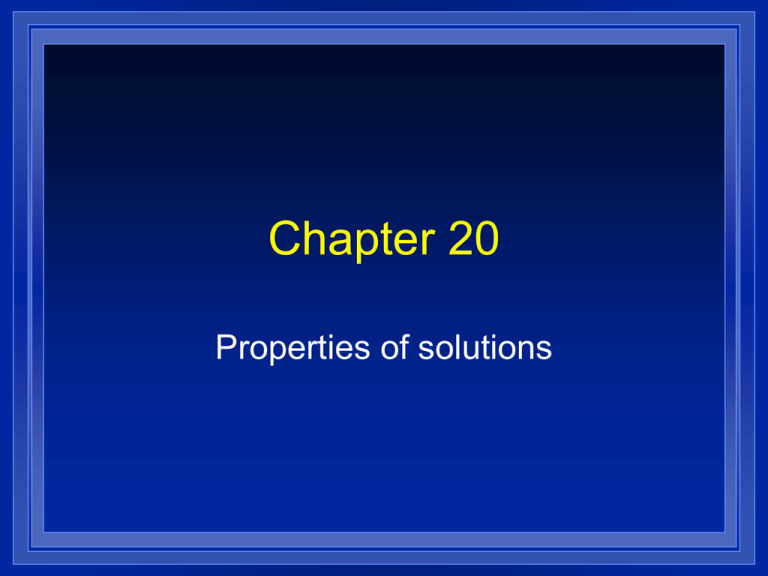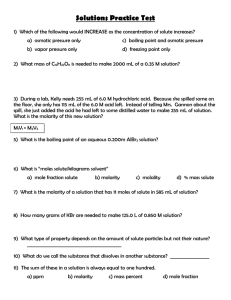Solutions
advertisement

Chapter 20 Properties of solutions Making solutions What the solute and the solvent are – Whether a substance will dissolve. – How much will dissolve. A substance dissolves faster if It is stirred or shaken. The particles are made smaller. The temperature is increased. Why? Making solutions In order to dissolve the solvent molecules must come in contact with the solute. Stirring moves fresh solvent next to the solute. The solvent touches the surface of the solute. Smaller pieces increase the amount of surface of the solute. Temperature and Solutions Higher temperature makes the molecules of the solvent move around faster and contact the solute harder and more often. Speeds up dissolving. Usually increases the amount that will dissolve. How Much? Solubility- The maximum amount of substance that will dissolve at that temperature (usually g/L). Saturated solution- Contains the maximum amount of solid dissolved. Unsaturated solution- Can dissolve more solvent. Supersaturated- A solution that is temporarily holding more than it can, a seed crystal will make it come out Liquids Miscible means the that to liquids can dissolve in each other. Immiscible means they can’t What affects solubility? For solids in liquids as the temperature goes up the solubility goes up. For gases in a liquid as the temperature goes up the solubility goes down. For gases in a liquid- as the pressure goes up the solubility goes up. Measuring Solutions Concentration A measure of the amount of solute dissolved in a certain amount of solvent. Concentrated solution has a large amount of solute. Dilute solution has a small amount of solute Sometimes g/l or g/mL of g/100 mL. But chemical reactions don’t happen in grams Molarity The number of moles of solute in 1 Liter of the solution. M = moles/Liter What is the molarity of a solution with 2.0 moles of NaCl in 4.0 Liters of solution. What is the molarity of a solution with 3.0 moles dissolved in 250 mL of solution. Making solutions Pour in a small amount of solvent Then add the solute and dissolve it Then fill to final volume. M x L = moles How many moles of NaCl are needed to make 6.0 L of a 0.75 M NaCl solution? How many grams of CaCl2 are needed to make 625 mL of a 2.0 M solution? Making solutions 10.3 g of NaCl are dissolved in a small amount of water then diluted to 250 mL. What is the concentration? How many grams of sugar are needed to make 125 mL of a 0.50 M C6H12O6 solution? Dilution Adding water to a solution The Dilution number of moles of solute doesn’t change if you add more solvent. The moles before = the moles after M1 x V1 = M2 x V2 M1 and V1 are the starting concentration and volume. M2 and V2 are the starting concentration and volume. Stock solutions are pre-made to known M Practice 2.0 L of a 0.88 M solution are diluted to 3.8 L. What is the new molarity? You have 150 mL of 6.0 M HCl. What volume of 1.3 M HCl can you make? Need 450 mL of 0.15 M NaOH. All you have available is a 2.0 M stock solution of NaOH. How do you make the required solution? Percent solutions Percent means per 100 so Percent by volume = Volume of solute x 100% Volume of solution indicated %(v/v) What is the percent solution if 25 mL of CH3OH is diluted to 150 mL with water? Percent Percent solutions by mass = Mass of solute(g) x 100% Volume of solution(mL) Indicated %(m/v) More common 4.8 g of NaCl are dissolved in 82 mL of solution. What is the percent of the solution? How many grams of salt are there in 52 mL of a 6.3 % solution? Colligative Properties Depend only on the number of dissolved particles Not an what kind of particle Vapor Pressure The bonds between molecules keep molecules from escaping. In a solution, some of the solvent is busy keeping the solute dissolved. Lowers the vapor pressure. Electrolytes form ions when dissolved - more pieces. NaCl Na+ + Cl- 2 pieces More pieces bigger effect. Boiling Point Elevation The vapor pressure determines the boiling point. Lower vapor pressure - higher boiling point. Salt water boils above 100ºC The solvent determines how much. Freezing Point Depression Solids form when molecules make an orderly pattern. The solute molecules break up the orderly pattern. Makes the freezing point lower. Salt water freezes below 0ºC How much depends on the solvent. Molality a new unit for concentration m = Moles of solute kilogram of solvent m = Moles of solute 1000 g of solvent What is the molality of a solution with 9.3 mole of NaCl in 450 g of water? Why molality? The size of the change in boiling point is determined by the molality. DTb = Kb x m x n DTb is the change in the boiling point Kb is a constant determined by the solvent(pg 387). m is the molality of the solution. n is the number of pieces it falls into when it dissolves. What about Freezing? The size of the change in freezing point is determined by the molality. DTf = -Kf x m x n DTf is the change in the boiling point Kf is a constant determined by the solvent(pg 388). m is the molality of the solution. n is the number of pieces it falls into when it dissolves. Problems What is the boiling point of a solution made by dissolving 1.20 moles of NaCl in 750 g of water? What is the freezing point? What is the boiling point of a solution made by dissolving 1.20 moles of CaCl2 in 750 g of water? What is the freezing point?






